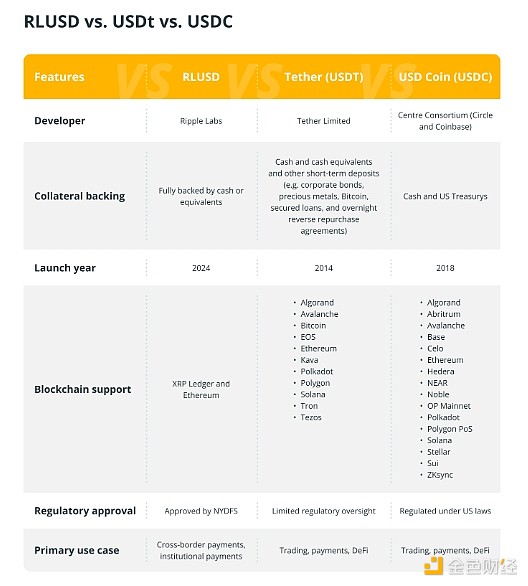
Author: Marcel Deer, CoinTelegraph; Compiled by: Whitewater, Golden Finance
1. What is Ripple Labs’ RLUSD stablecoin?RLUSD is a stablecoin developed by Ripple Labs, the organization behind the XRP cryptocurrency. RLUSD, or Ripple Labs USD, aims to provide a stable digital currency for trading and trading.
As a stablecoin pegged to the U.S. dollar, 1 RLUSD is equal to 1 U.S. dollar. Each RLUSD maintains a 1:1 peg. These collateral assets are either U.S. dollar deposits or cash equivalents.
On December 10, 2024, RLUSD received regulatory approval. The New York Department of Financial Services approved the XRP distributed ledger and a new stablecoin on the Ethereum blockchain.
One week later, on December 17, RLUSD was officially launched and listed on five crypto exchanges: Uphold, MoonPay, Archax, Bitso and CoinMENA. Over time, Bitcoin's availability will expand to include well-known companies such as Bullish, Bitcstamp, and Bitcoin Market.
RLUSD will be included in the Ripple payment network in 2025. The Ripple payment network will provide stablecoins to corporate customers who require global payments. It is expected to lead to efficient and cheap cross-border transactions, especially for institutions.
Will RLUSD replace XRP? Ripple has confirmed that it is not a replacement for XRP. RLUSD is a form of digital cash.
2. How does the RLUSD stablecoin work?RLUSD works similarly to other stablecoins that are primarily pegged to the U.S. dollar, allowing individuals and institutions to deposit capital assets such as U.S. dollars to mint each new coin. Cryptocurrencies can be traded on the Ethereum and XRP Ledger blockchains.
There is nothing inherently new about the technology and concept of Ripple’s new stablecoin. It is a direct competitor to established players USDT and USDC.
Collateral backing ensures that prices remain stable and avoids the volatility issues that some other cryptocurrencies have. This reliability allows businesses and traders to trade away from unpredictable price fluctuations.
RLUSD is available on the XRP Ledger and Ethereum blockchains. Therefore, you can use it as a trading pair on an exchange or to send and receive trades with others.
The following are the differences between RLUSD and USDT and USDC:
3. Advantages of RLUSD stable currencyRipple Labs’ RLUSD relies on strong advantages, making it reliable, trustworthy, and efficient, and is expected to become a leader in the stablecoin field.
Value Stability: RLUSD aims to maintain a stable value, which is a feature of RLUSD that improves crypto user payments and transactions.
Regulatory Approval: Approved by NYDFS and Ripple Labs as developers, RLUSD is a trustworthy crypto project. This gives it tremendous credibility upon launch.
Institutional Payments Focus: The token is designed for institutional payments, so organizations can expect smooth, fast, and cost-effective global transactions.
Broad Accessibility: Ripple is one of the biggest players in the blockchain world. They plan to launch RLUSD on multiple exchanges and will likely launch on every major cryptocurrency exchange soon.
Multi-blockchain support: The new stablecoin will run on two blockchains – XRP Ledger and Ethereum. It can be used flexibly across a wide ecosystem.
Fully Backed Reserves: Funding is guaranteed, with each RLUSD backed by an independent reserve of cash or cash equivalents. You can always convert RLUSD to USD at a 1:1 ratio.
(The U.S. Securities and Exchange Commission (SEC) filed a lawsuit against Ripple Labs in December 2020. The regulator accused Ripple of selling XRP as an unregistered security. It was not until July 2023 that Ripple achieved a partial victory , a judge ruled that XRP sold on exchanges was not a security, although institutional sales violated securities laws in October 2024. The decision was appealed in March, and the crypto world is still waiting for the final ruling)
IV. Use cases for RLUSD stablecoinRLUSD beta test results show that it is fast, reliable and cost-effective, making it usable for many purposes. financial use cases, including payments, trading, DeFi and tokenization.
RLUSD Cross-border payments: Cross-border payments are probably the biggest use of stablecoins such as RLUSD. They enable you to send money instantly to anywhere in the world at minimal cost. Useful in a globally connected economy.
Entry/Exit Channels: Cashing out with cryptocurrencies can be a challenge. RLUSD provides useful entry/exit lanes for traders to enter and exit the exchange without the risk of volatility.
Everyday Payments: Ripple Lab calls the stablecoin “digital cash,” suggesting they want to use it for smaller, everyday payments. Another convenient use for a fast and stable cryptocurrency.
Asset Tokenization: RLUSD enables you to tokenize real-world assets. Specifically, it allows institutions to trade real-world tokenized assets such asbonds, commodities and securities) to provide collateral.
DeFi: As RLUSD is integrated into the Ethereum blockchain, it will provide a trusted stablecoin to integrate into DeFi protocols. You shouldn’t be surprised to see it used as a collateral option for decentralized exchange (DEX) trading pairs or lending protocols.
5. Future Prospects of RLUSD Stable CoinRLUSD has grand plans. Ripple expects its market capitalization to exceed $2 trillion by 2028.
This is ambitious considering Bitcoin only hit $2 trillion on November 11th. December 2024 – 15 years after launch. USDT, the world’s leading stablecoin, was capped at $138 billion at the time.
Subject to regulatory approval, RLUSD will launch in late 2025 and looks promising.
Details of the release of Ripple’s stablecoin have been slowly revealed over the past few months, since testing began on the XRP Ledger and Ethereum mainnet in August. The differences between RLUSD and XRP are quite clear and it has been confirmed that it is not a replacement for XRP but will instead complement Ripple’s cross-border payment solutions.
Ripple has committed to stablecoin auditing and transparency, and conducts regular third-party audits of collateral reserves alongside monthly financial reporting. However, details of who will conduct the audit process have yet to be determined.














